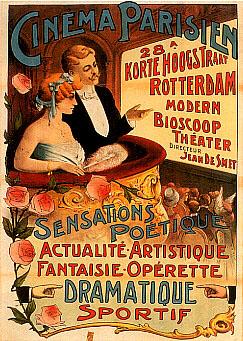It is not important what goes on each frame of film; it’s the spaces between frames that are important (Norman McLaren)
Critics and commentators have remarked upon the induced reverie and pleasure associated with watching films, invariably characterising this as a magical experience. In the undue haste to replace film with digital (binary) video technology, few have considered the important role of the shutter in viewing the projected motion picture.
Typically (in shutter-based projection), theatre audiences viewing film on a screen spend half their time in darkness. This is thought to simultaneously relax the brain and increase active engagement as the mind “fills the gaps” between each shutter interruption. In this way, the brain constructs perception of movement from distinct still frames.
Specific research into the physiological and psychological aspects of motion picture viewing has been hard to find, though Gestalt psychology has explored connected concepts such as the Phi-Phenomenon and Beta Movement1. However, in 2012, the Zürcher Hochschule der Künste / ZHdK, Switzerland, commenced formal research into the differences between viewing projected motion pictures and digital video-based images2. Although the full results of this study are not yet available, a preliminary outcome found that
Im Gegensatz zum Aufnahmeverfahren beeinflusst die Projektionsweise die Wirkung deutlich; die emotionale Wirkung ist bei analoger Projektion tendenziell höher, wobei die Stärke wiederum je nach Film variiert.3
(In contrast to the recording process, the projection method clearly influences the effect; the emotional impact of analogue projection tends to be stronger, the intensity of which varies from film to film.)
This preliminary research suggests a link between the singular nature of film projection and one’s emotional involvement in the action portrayed on screen. The film projection experience may have greater impact because the viewer is physiologically engaged in the viewing process via the shutter interruptions. If it could be proved that non-film-based projection methods deprive audiences of physiological and mental engagement in the viewing process, that could partly explain why there has been notable resistance to digital projection in theatres and might be a contributing factor to recent recorded declines in cinema admissions in some parts of the world.
These concepts also have a bearing on the emerging field of audience rights. It can be asserted that denial of the ability to properly engage with motion pictures – in effect, enforced viewing passivity – is a breach of the people’s right freely to participate in the cultural life of the community, to enjoy the arts and impedes the right of artists to freely communicate information and ideas.
The need to preserve the active, engaging motion picture projection experience for filmmakers and audiences alike highlights the precariousness of a film culture and infrastructure that is in the main supported and controlled by private companies. Such companies determine the supply of and access to film-related products and equipment. This environment is increasingly unreliable. In order to preserve people’s access to the motion picture viewing experience, there will have to be intervention at national and international level4.
The Zürcher Hochschule der Künste research moves discussion and consideration of this important area from an abstract position to a more concrete foundation. It constitutes an advancement in understanding and a welcome re-introduction of film viewers to this discussion.
1. The Phi-Phenomenon is a process that is carried out in the visual cortex of the brain in which spaces between static visual elements in sequence are used, in part, to construct a perception of movement.
Related to this is a similar, but distinct process called Beta Movement, which also contributes to the perception of movement between otherwise still images.
What is commonly referred to as Persistence of Vision (i.e. after-images on the retina of the eye) in fact appears to play only a minor role in the motion picture viewing process, with some claiming that it operates mostly only to reduce perceived flicker.
The human visual system and brain do not have to continuously take in images in film projection, due to the shutter interruptions approximately every 1/48 of a second (for projectors with two-bladed shutters).
2. ANALOG / DIGITAL: The Emotional Impact of Film Recording Processes on the Audience (Study by Zürcher Hochschule der Künste / ZHdK, Switzerland)
4. See the recent SaveFilm.org initiative, which the Film Advocacy Task Force wholeheartedly supports.
Additional References
Steinman, R. M., Z. Pizlo, & F.J. Pizlo. Phi is not beta, and why Wertheimer’s discovery launched the Gestalt revolution: a minireview (2000). Vision Research, 40, 2257{2264. http://www.ncbi.nlm.nih.gov/pubmed/10927113 (Abstract)
http://peace.saumag.edu/faculty/kardas/courses/Learning/phiphenomenon.htm
(Phi-Phenomenon)
http://www.indiana.edu/~audioweb/T284/ beta-phi.html
(Examples of Phi and Beta Movement)
http://www.oglethorpe.edu/faculty/~k_sorenson/documents/Ch12Gestalt.ppt#312,37,
Contributions of Gestalt psychology
(Phi Phenomenon and Gestalt Psychology)
http://indiekicker.reelgrok.com/the-magic-that-happens-between-the-frames/
http://www.pamcole.com/DOCS/POV.html
(Critique of Persistence of Vision theory)
http://www.hfs.hr/hfs/ljetopis_clanak_detail_e.asp?sif=1344
(Movement Illusion in Film – Myths and Explanations)
Motion Picture Persistence of Vision: “How You See It”
(1936 Chevrolet Educational Short Film explaining
Basic Principles of the Motion Picture Projector)
http://variety.com/2014/film/news/number-of-frequent-young-moviegoers-plummets-in-2013-1201146426/#
http://www.obs.coe.int/documents/205595/264487/Berlinale2014-Graph.png/433ab96a-55cd-4013-8dcb-4ae4191655fa?t=1392304692000?t=1392304692628
(Cinema Attendances – EU)
Image: Bioscoopaffiche, Nederlands Filmmuseum, Amsterdam, 1909,
by Julien t’ Felt (1874-1933)
Public domain / PD-Art
Public domain in the United States / PD-US

